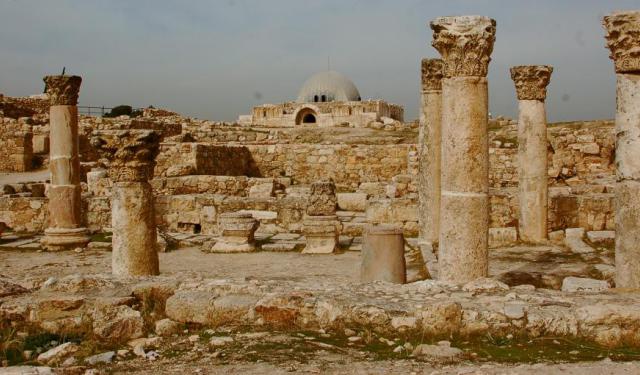Byzantine Church Ruins, Amman
The Byzantine Church was constructed in the 6th century AD. It is characterized by its basilica plan, a hallmark of Byzantine architectural design. Its architectural layout comprises a central nave flanked by two side aisles. This arrangement created a sense of grandeur within the sacred space, allowing congregants to gather and worship in an awe-inspiring environment.
The eastern end of the church culminates in a semi-circular apse, a distinctive feature that served as a focal point for religious ceremonies and rituals. Separated from the main body of the church by a chancel screen, the apse held profound spiritual significance, and its design and decoration held deep religious symbolism.
Intriguingly, the Corinthian capitals that adorn some of the columns within the basilica were repurposed from the nearby Temple of Hercules. The aisles of the church, designed with meticulous attention to detail, feature flagstone paving that adds both practicality and aesthetic value to the sacred space. The meticulous craftsmanship of the era is evident in every stone.
Adjacent to the main basilica, one can discover rectangular rooms, which are believed to have been added by the Umayyads approximately a century later. These additions are a testament to the enduring significance of the site across different epochs.
One of the most captivating features of the Byzantine Church is its mosaic-paved nave, a characteristic feature of the Byzantine period. While the mosaic floor is now covered for protection, it harkens back to a time when the church's interior would have been adorned with intricate and colorful designs, reflecting the artistic and religious sensibilities of the era.
The eastern end of the church culminates in a semi-circular apse, a distinctive feature that served as a focal point for religious ceremonies and rituals. Separated from the main body of the church by a chancel screen, the apse held profound spiritual significance, and its design and decoration held deep religious symbolism.
Intriguingly, the Corinthian capitals that adorn some of the columns within the basilica were repurposed from the nearby Temple of Hercules. The aisles of the church, designed with meticulous attention to detail, feature flagstone paving that adds both practicality and aesthetic value to the sacred space. The meticulous craftsmanship of the era is evident in every stone.
Adjacent to the main basilica, one can discover rectangular rooms, which are believed to have been added by the Umayyads approximately a century later. These additions are a testament to the enduring significance of the site across different epochs.
One of the most captivating features of the Byzantine Church is its mosaic-paved nave, a characteristic feature of the Byzantine period. While the mosaic floor is now covered for protection, it harkens back to a time when the church's interior would have been adorned with intricate and colorful designs, reflecting the artistic and religious sensibilities of the era.
Want to visit this sight? Check out these Self-Guided Walking Tours in Amman. Alternatively, you can download the mobile app "GPSmyCity: Walks in 1K+ Cities" from Apple App Store or Google Play Store. The app turns your mobile device to a personal tour guide and it works offline, so no data plan is needed when traveling abroad.
Byzantine Church Ruins on Map
Sight Name: Byzantine Church Ruins
Sight Location: Amman, Jordan (See walking tours in Amman)
Sight Type: Attraction/Landmark
Guide(s) Containing This Sight:
Sight Location: Amman, Jordan (See walking tours in Amman)
Sight Type: Attraction/Landmark
Guide(s) Containing This Sight:
Walking Tours in Amman, Jordan
Create Your Own Walk in Amman
Creating your own self-guided walk in Amman is easy and fun. Choose the city attractions that you want to see and a walk route map will be created just for you. You can even set your hotel as the start point of the walk.
Amman Introduction Walking Tour
The capital of Jordan, Amman, is a city that successfully marries rich history with the bustling vibrancy of a modern metropolis. A place where ancient tales and contemporary life intersect.
The earliest evidence of human settlement in the area dates back to the 8th millennium BC. Initially, in the second millennium BC, the city was known as Rabat Aman and served as the capital of the Ammonite... view more
Tour Duration: 2 Hour(s)
Travel Distance: 4.3 Km or 2.7 Miles
The earliest evidence of human settlement in the area dates back to the 8th millennium BC. Initially, in the second millennium BC, the city was known as Rabat Aman and served as the capital of the Ammonite... view more
Tour Duration: 2 Hour(s)
Travel Distance: 4.3 Km or 2.7 Miles
Roman Ruins Walking Tour
Once dominated by the Romans, the modern-day Jordanian capital, Amman, still boasts that legacy. The area known as the Citadel, sitting on the highest hill in Amman, Jebel Al Qala’a, some 850 meters above sea level, offers plenty to see.
Perched atop the Citadel, the Umayyad Palace is a captivating sight. Dating back to the 8th century, it showcases intricate Islamic architecture and affords... view more
Tour Duration: 2 Hour(s)
Travel Distance: 3.0 Km or 1.9 Miles
Perched atop the Citadel, the Umayyad Palace is a captivating sight. Dating back to the 8th century, it showcases intricate Islamic architecture and affords... view more
Tour Duration: 2 Hour(s)
Travel Distance: 3.0 Km or 1.9 Miles





